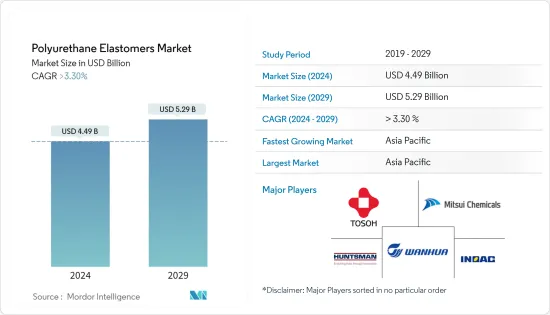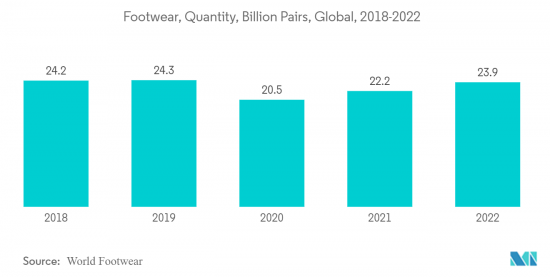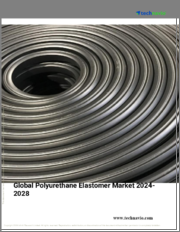
|
시장보고서
상품코드
1405718
폴리우레탄 엘라스토머 : 시장 점유율 분석, 산업 동향과 통계, 성장 예측(2024-2029년)Polyurethane Elastomers - Market Share Analysis, Industry Trends & Statistics, Growth Forecasts 2024 - 2029 |
||||||
폴리우레탄 엘라스토머 시장 규모는 2024년에 44억 9,000만 달러로 추정되며, 2029년에는 52억 9,000만 달러에 달할 것으로 예측되며, 예측 기간 중(2024-2029년) CAGR은 3.30% 이상으로 성장할 것으로 예측됩니다.

COVID-19 기간 중 경제 활동의 위축으로 인해 자동차 부품, 소비재, 건축자재 등 폴리우레탄 엘라스토머를 사용한 제품에 대한 수요가 감소했습니다. 그러나 상황이 회복되면서 시장의 성장 궤도가 회복되고 있으며, 예측 기간 중에도 성장할 것으로 예상됩니다.
주요 하이라이트
- 폴리우레탄 엘라스토머(PUE)는 인구 증가에 따라 깔창, 미드솔, 아웃솔을 제조하는 신발 산업에서 수요가 증가하면서 시장을 독점하고 있습니다.
- PUE는 자동차 부품, 의료, 항공우주와 같은 고성능 용도에 자주 사용됩니다. 그러나 열, 자외선, 화학물질 및 기타 환경적 요인에 노출되어 노화되기 쉽고 내구성이 낮다는 점이 시장을 제한하고 있습니다.
- 바이오 폴리우레탄 제품에 대한 수요 증가는 향후 수년간 이 시장에 기회가 될 수 있습니다.
- 아시아태평양이 폴리우레탄 엘라스토머 시장을 독점하고 있으며, 인도, 중국, 일본이 주요 소비국입니다.
폴리우레탄(PU) 엘라스토머 시장 동향
급성장하는 시장을 대표하는 신발산업
- 폴리우레탄 엘라스토머(PU)는 고무의 특성을 가진 폴리우레탄 그룹의 일종입니다. 폴리우레탄 엘라스토머는 딱딱한 부분(이소시아네이트)과 탄력적인 부분(폴리올)을 결합하여 형성되며, 이러한 선택에 따라 폴리우레탄 엘라스토머의 우수한 품질이 만들어집니다.
- 폴리우레탄 엘라스토머는 주로 신발 산업에서 사용되며, "0℃-80℃"의 온도 범위에서 유연성을 조절하는 배합을 사용하여 고강도 및 유연성 신발 밑창을 생산하여 우수한 품질과 내구성을 가진 제품을 생산합니다.
- World Footwear Yearbook 2022에 따르면 세계 신발 생산량은 7.6% 증가한 23억 9,000만 켤레로 COVID-19 이전 수준과 거의 비슷했습니다.
- 2022년 신발 시장 매출 순위는 미국이 858억 4,000만 달러로 선두를 달리고 중국이 793억 2,000만 달러로 그 뒤를 이어 빠르게 성장하고 있는 것으로 나타났습니다. 따라서 전년 대비 이 분야의 성장을 보여주고 있습니다.
- 인도 중앙은행 보고서 2022에 따르면 인도에서 수출된 가죽 및 가죽 제품 금액은 3,260억 루피(-41억 4,000만 달러)가 넘었습니다. 이는 전년도 2,440억 루피(-31억 달러) 이상에 비해 33% 증가했으며, 여기에는 신발 제품도 포함됩니다. 예측 기간 중 PU 엘라스토머 시장은 증가할 것으로 예상됩니다.
- 인구 증가는 중국, 인도, 일본 등 국가의 신발 산업 시장을 촉진하여 폴리우레탄 엘라스토머의 주요 시장을 형성하고 있습니다.

아시아태평양이 시장을 장악할 것입니다.
- 예측 기간 중 아시아태평양이 폴리우레탄 엘라스토머 시장을 주도할 것으로 예상됩니다. 중국, 인도 등의 국가에서는 신발, 가죽, 자동차 등 소비재 산업에서 폴리우레탄 엘라스토머의 사용이 증가함에 따라 폴리우레탄 엘라스토머 시장이 확대되고 있습니다.
- 폴리우레탄 엘라스토머는 높은 동적 응력이 예상되는 곳에서도 사용됩니다. 이러한 엘라스토머는 수분 투과를 억제하고 마모로 인한 손상을 방지하기 위해 내식성이 선호되는 경우 코팅제로도 사용됩니다.
- World Footwear Yearbook 2022에 따르면 신발 산업은 여전히 아시아에 집중되어 있으며, 10켤레의 신발 중 거의 9켤레가 아시아에서 생산되고 있습니다.
- 아시아태평양 국가 중 중국, 인도, 베트남, 인도네시아가 2022년 기준 세계 신발 생산량의 75% 이상을 차지할 것으로 보입니다. 중국은 세계 최대 신발 생산국으로 2022년 점유율이 54.6%로 소폭 증가하여 최근 몇 년간의 감소 추세를 반전시켰습니다.
- 또한 베트남은 10.3%로 가장 높은 생산 증가율을 기록하며 PU 엘라스토머 시장을 주도하고 있습니다.
- PU 엘라스토머는 서스펜션 부싱, 개스킷 및 실, 범퍼, 휠 및 타이어, 호스 및 튜브, 인테리어 트림 등 다양한 자동차 부품에 사용됩니다. 폴리우레탄 엘라스토머의 인장 강도, 압축 강도, 인열 강도와 같은 물리적 특성으로 인해 자동차 산업에서 수요가 증가하고 있습니다.
- OICA 데이터에 따르면 2022년 중국 자동차 산업은 약 2,380만 대의 승용차를 생산할 것이며, 아시아태평양에서 가장 많은 승용차를 생산하는 지역으로 예측 기간 중 시장을 주도하는 PU 엘라스토머에 영향을 미칠 것으로 보입니다.
- 위의 요인은 정부의 지원과 함께 예측 기간 중 폴리우레탄 엘라스토머에 대한 수요 증가에 기여하고 있습니다.
폴리우레탄(PU) 엘라스토머 산업 개요
세계의 폴리우레탄 엘라스토머 시장은 세분화되어 있습니다. 주요 기업으로는 Tosoh India Pvt. Ltd., Mitsui Chemicals, Inc., Wanhua, INOAC CORPORATION, Huntsman International LLC 등이 있습니다.
기타 특전 :
- 엑셀 형식의 시장 예측(ME) 시트
- 3개월간의 애널리스트 지원
목차
제1장 서론
- 조사의 전제조건
- 조사 범위
제2장 조사 방법
제3장 주요 요약
제4장 시장 역학
- 촉진요인
- 신발 산업으로부터의 수요 증가
- 자동차 산업과 소비재 산업에서 용도의 확대
- 기타 촉진요인
- 억제요인
- 폴리우레탄 엘라스토머의 내구성 저하
- 폴리우레탄에 의한 환경에 대한 우려
- 밸류체인 분석
- Porter's Five Forces 분석
- 공급 기업의 교섭력
- 구매자의 교섭력
- 신규 진출업체의 위협
- 대체품의 위협
- 경쟁의 정도
제5장 시장 세분화
- 유형
- 열가소성
- 열경화성
- 용도
- 신발
- 산업 기계
- 자동차·운송 기기
- 기타(건축·건설, 광산기계, 의료)
- 지역
- 아시아태평양
- 중국
- 인도
- 일본
- 한국
- 기타 아시아태평양
- 북미
- 미국
- 캐나다
- 멕시코
- 유럽
- 독일
- 영국
- 프랑스
- 이탈리아
- 기타 유럽
- 남미
- 브라질
- 아르헨티나
- 기타 남미
- 중동 및 아프리카
- 사우디아라비아
- 남아프리카공화국
- 기타 중동 및 아프리카
- 아시아태평양
제6장 경쟁 구도
- M&A, 합병사업, 제휴, 협정
- 시장 점유율(%)**/순위 분석
- 주요 기업의 전략
- 기업 개요
- American Urethane, Inc.
- Argonics
- Covestro AG
- Dow
- Huntsman International LLC.
- INOAC CORPORATION
- LANXESS
- Mitsui Chemicals, Inc.
- Ravelast Polymers
- Tosoh India Pvt. Ltd.
- The Lubrizol Corporation
- Unicast Engineered Urethane Products
- Wanhua
- Weaver Industries, Inc.
제7장 시장 기회와 향후 동향
- 바이오 기반 폴리우레탄 엘라스토머에 대한 수요 증가
- 기타 기회

The Polyurethane Elastomers Market size is estimated at USD 4.49 billion in 2024, and is expected to reach USD 5.29 billion by 2029, growing at a CAGR of greater than 3.30% during the forecast period (2024-2029).
During COVID-19, the reduced economic activity led to decreased demand for products using polyurethane elastomers, such as automotive components, consumer goods, and construction materials. However, the condition has recovered, thereby restoring the growth trajectory of the market, and is expected to grow over the period.
Key Highlights
- Polyurethane elastomers (PUEs), rising in demand from the footwear industry for producing insoles, midsoles, or outsoles, are dominating the market owing to the increasing population.
- PUEs are often used in high-performance applications such as automotive parts, medical, and aerospace. However, they have lower durability as they are susceptible to degradation over time due to exposure to heat, UV radiation, chemicals, and other environmental factors, restricting the market.
- Increasing demand for bio-based polyurethane products could act as an opportunity for this market in the coming years.
- Asia-Pacific region dominated the market for polyurethane elastomers, with India, China, and Japan as major countries in consumption.
Polyurethane (PU) Elastomers Market Trends
Footwear Industry Representing the Fastest Growing Market
- Polyurethane elastomers (PU) are a class of the polyurethane group that have the characteristics of rubber. Polyurethane elastomers are formed by combining hard (isocyanate) and elastic (polyol) parts, and changing these selections creates the superior quality of the polyurethane elastomers.
- Polyurethane elastomers are majorly used in the footwear industry to produce high tensile and flexible soles using formulations that regulate flexibility ranging from temperatures '0 degrees Celsius to 80 degrees Celsius' thereby producing superior quality and durable products, increasing the scope for this market.
- As per the World Footwear Yearbook 2022, global footwear production increased by 7.6% to reach 23.9 billion pairs, roughly standing at pre-pandemic levels.
- In 2022, the revenue ranking in the footwear market is led by the United States with USD 85.84 billion, while China is following with USD 79.32 billion, showing a rapid growth company. Hence showing growth in the sector compared to the previous year.
- According to the Reserve Bank of India report 2022, the value of leather and leather products exported from India amounted to over INR 326 billion (~USD 4.14 billion). This was an increase of 33% compared to the previous year's value of over INR 244 billion (~USD 3.1 billion ), which includes footwear products. It is expected to increase in the PU elastomers market during the forecast period.
- The growing population is aiding the market for the footwear industry in countries like China, India, and Japan creating a major market for polyurethane elastomers.

Asia-Pacific Region to Dominate the Market
- Asia Pacific region is expected to dominate the market for polyurethane elastomers during the forecast period. In countries like China and India, due to the increasing applications in footwear and other consumer goods industries like leather and automotive, the market for polyurethane elastomers has been increasing.
- Elastomers of polyurethane are also used where a high degree of dynamic stress is anticipated. These elastomers are also used as coatings when corrosion resistance is preferred for inhibiting moisture transmission and preventing abrasion damage.
- As per the World Footwear Yearbook 2022, the footwear industry continues to be strongly concentrated in Asia, where almost 9 out of every 10 pairs of shoes are manufactured, resulting in a share of 87.4% of the world's total driving PU elastomers market.
- Among Asia-Pacific countries, China, India, Vietnam, and Indonesia accounted for over 75% of footwear production worldwide as of 2022. China is the world's largest footwear producer, marginally increasing its share in 2022 to 54.6%, reversing the downward trend observed in recent years.
- Moreover, Vietnam experienced the highest production growth of 10.3%, which has a direct impact on driving the PU elastomers market.
- The PU elastomers are used across various automobile components such as suspension bushing, gaskets and seals, bumpers, wheels and tires, hoses and tubing, interior trim, and other components. The physical properties of polyurethane elastomers, such as tensile strength, compression strength, and tear strength, are increasing their demand in the automobile industry.
- According to the OICA data, for 2022, China's automotive industry 2022 produced approximately 23.8 million passenger cars, and it is also the most passenger cars in the Asia-Pacific region, which has an impact on PU elastomers driving the market during the forecast period.
- The factors mentioned above, coupled with government support, are contributing to the increasing demand for polyurethane elastomers during the forecast period.
Polyurethane (PU) Elastomers Industry Overview
The global polyurethane elastomers market is fragmented in nature. The major players (not in any particular order) include Tosoh India Pvt. Ltd., Mitsui Chemicals, Inc., Wanhua, INOAC CORPORATION, and Huntsman International LLC among others.
Additional Benefits:
- The market estimate (ME) sheet in Excel format
- 3 months of analyst support
TABLE OF CONTENTS
1 INTRODUCTION
- 1.1 Study Assumptions
- 1.2 Scope of the Study
2 RESEARCH METHODOLOGY
3 EXECUTIVE SUMMARY
4 MARKET DYNAMICS
- 4.1 Drivers
- 4.1.1 Increasing Demand from Footwear Industry
- 4.1.2 Growing Application in Automotive and Consumer Goods Industries
- 4.1.3 Other Drivers
- 4.2 Restraints
- 4.2.1 Lower Durability of Polyurethane Elastomers
- 4.2.2 Environmental Concerns Caused by Polyurethane
- 4.3 Industry Value Chain Analysis
- 4.4 Porter's Five Forces Analysis
- 4.4.1 Bargaining Power of Suppliers
- 4.4.2 Bargaining Power of Buyers
- 4.4.3 Threat of New Entrants
- 4.4.4 Threat of Substitute Products and Services
- 4.4.5 Degree of Competition
5 MARKET SEGMENTATION
- 5.1 Type
- 5.1.1 Thermoplastic
- 5.1.2 Thermoset
- 5.2 Application
- 5.2.1 Footwear
- 5.2.2 Industrial Machinery
- 5.2.3 Automotive & Transportation
- 5.2.4 Others (Building & Construction, Mining Equipment, and Medical)
- 5.3 Geography
- 5.3.1 Asia-Pacific
- 5.3.1.1 China
- 5.3.1.2 India
- 5.3.1.3 Japan
- 5.3.1.4 South Korea
- 5.3.1.5 Rest of Asia-Pacific
- 5.3.2 North America
- 5.3.2.1 United States
- 5.3.2.2 Canada
- 5.3.2.3 Mexico
- 5.3.3 Europe
- 5.3.3.1 Germany
- 5.3.3.2 United Kingdom
- 5.3.3.3 France
- 5.3.3.4 Italy
- 5.3.3.5 Rest of Europe
- 5.3.4 South America
- 5.3.4.1 Brazil
- 5.3.4.2 Argentina
- 5.3.4.3 Rest of South America
- 5.3.5 Middle-East and Africa
- 5.3.5.1 Saudi Arabia
- 5.3.5.2 South Africa
- 5.3.5.3 Rest of Middle-East and Africa
- 5.3.1 Asia-Pacific
6 COMPETITIVE LANDSCAPE
- 6.1 Mergers and Acquisitions, Joint Ventures, Collaborations, and Agreements
- 6.2 Market Share (%)**/Ranking Analysis
- 6.3 Strategies Adopted by Leading Players
- 6.4 Company Profiles
- 6.4.1 American Urethane, Inc.
- 6.4.2 Argonics
- 6.4.3 Covestro AG
- 6.4.4 Dow
- 6.4.5 Huntsman International LLC.
- 6.4.6 INOAC CORPORATION
- 6.4.7 LANXESS
- 6.4.8 Mitsui Chemicals, Inc.
- 6.4.9 Ravelast Polymers
- 6.4.10 Tosoh India Pvt. Ltd.
- 6.4.11 The Lubrizol Corporation
- 6.4.12 Unicast Engineered Urethane Products
- 6.4.13 Wanhua
- 6.4.14 Weaver Industries, Inc.
7 MARKET OPPORTUNITIES AND FUTURE TRENDS
- 7.1 Increasing Demand for Bio-based Polyurethane Elastomers
- 7.2 Other Opportunities













